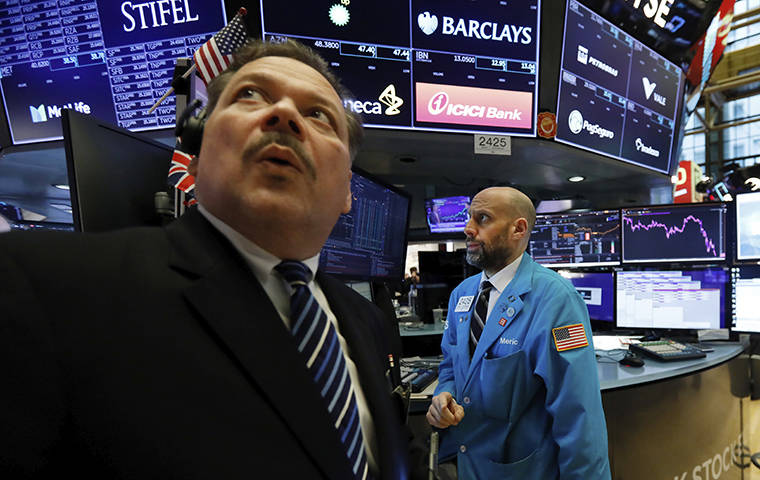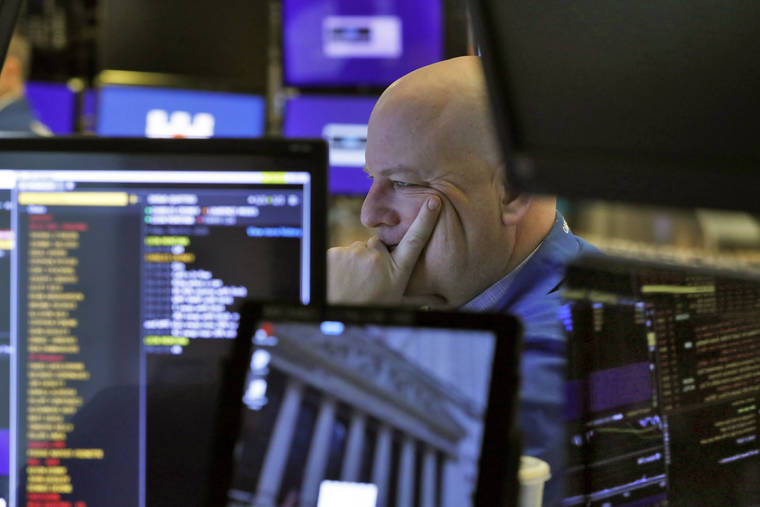Dow closes down 256 points after clawing back large losses

ASSOCIATED PRESS
Trader John Santiago, left, looked at the numbers as he worked on the floor of the New York Stock Exchange, today. Major indexes ended down 1% or more after clawing back much larger losses earlier in the day.

ASSOCIATED PRESS
A trader studied his screens as he prepared for the day’s activities on the floor of the New York Stock Exchange, today.


NEW YORK >> A dizzying, brutal week of trading dropped one last round of harrowing swings on investors today.
After skidding sharply through the day as fear pounded markets, steep drops for stocks and bond yields suddenly eased up in the last hour. By the end of trading, the S&P 500 had more than halved its loss for the day to 1.7% and even locked in a gain for the week.
It’s the latest lurch in a wild ride that has sent stocks flipping between huge gains and losses — mostly losses the last two weeks. Investors are trying to guess how much economic damage the coronavirus will ultimately inflict, and they’re shifting by the minute as the number of new infections piles up on one hand and central banks and governments offer stimulus on the other.
All the uncertainty has left markets churning.
“It’s anyone’s guess at this point why it rallied into the close,” Adam Taback, chief investment officer for Wells Fargo Private Bank, said of the last hour of today’s trading.
Earlier in the day, the S&P 500 had been down 4%. Even more alarming was another breathtaking drop in Treasury yields to record lows.
Don't miss out on what's happening!
Stay in touch with breaking news, as it happens, conveniently in your email inbox. It's FREE!
The 10-year Treasury yield falls when investors are worried about a weaker economy and inflation, and it sank below 0.70% at one point. Earlier this week, it had never in history been below 1%. It was at 1.90% at the start of the year, before the virus fears took hold.
Even a better-than-expected report on U.S. jobs wasn’t enough to pull markets from the undertow. It’s usually the most anticipated piece of economic data each month, but investors looked past February’s solid hiring numbers because they came from before the new coronavirus was spreading quickly across the country.
“The bond market says the monster under the bed is much bigger and scarier than anyone expects right now,” said Ryan Detrick, senior market strategist at LPL Financial.
At the heart of the drops is the fear of the unknown. The virus usually causes only mild to moderate symptoms. But because it’s new, experts aren’t sure how far it will spread and how much damage it will ultimately do, both to health and to the economy.
The number of infections has topped 100,000 worldwide and businesses are reporting hits to their earnings. Danger for companies is coming from two sides. On the supply side, for example, Apple has said slowdowns in manufacturing iPhones in China will hurt its sales totals. On the demand side, an airline industry group says the outbreak could lose as much as $113 billion in revenue as people cancel trips.
Today’s drop for the S&P 500 was the latest swing in a remarkably turbulent week. It started off with a 4.6% jump on Monday, then fell 2.8%, rose 4.2% and fell 3.4%.
“At this point no one can really explain why the markets behave the way they do, and what may be next,” said Ipek Ozkardeskaya, a senior analyst at Swissquote Bank. “The only thing we can say is this high volatility is bad.”
It was only two weeks ago that the S&P 500 set a record high, on Feb. 19. It’s lost 12.2% since then.
The bond market sounded the alarm on the effects of the virus long before the stock market, and yields fell further Friday.
The Fed surprised the market earlier this week by cutting interest rates half a percentage point. Investors expect other central banks around the world to follow suit in hopes of supporting markets.
Eric Rosengren, president of the Boston Federal Reserve Bank, said today the Fed could start using new tools to combat a downturn, such as buying a broader range of financial assets.
At the same time, doubts are high about how much effect lower rates can have. Cheaper loans may encourage people and business to make big purchases, but they can’t get workers back into factories if they’re out on quarantine.
A boost for stocks came earlier this week after Congress agreed on an $8.3 billion bill to combat the coronavirus, which President Donald Trump signed Friday. But investors say a slowdown in the economy seems inevitable, and many analysts expect the market’s sharp swings to continue as long as the number of new cases accelerates.
“As the market tries to find its bottom, it’s going to go up and down, up and down, until it has a reason to steadily change in one direction or the other,” said Taback of Wells Fargo Private Bank.
MARKET ROUNDUP:
The S&P 500 fell 51.57, or 1.7%, to 2,972.37. It rose 0.6% for the week.
The Dow Jones Industrial Average lost 256.50, or 1%, to 25,864.78. The Nasdaq fell 162.98, or 1.9%, to 8,575.62.
The yield on the 10-year Treasury dropped to 0.77% from 0.92% late Thursday. It rallied from as low as 0.66% earlier in the day, according to Tradweb.
Benchmark U.S. crude tumbled $4.62, or 10.1%, to settle at $41.28 per barrel. It was the worst day for oil in more than five years. Brent crude, the international standard, dropped $4.72, or 9.4%, to $45.27.
In Europe, the French CAC 40 dropped 4.1%, and the German DAX lost 3.4%. The FTSE 100 in London fell 3.6%.
Japan’s Nikkei 225 fell 2.7%, South Korea’s Kospi lost 2.2% and stocks in Shanghai dropped 1.2%.
Gold rose $4.40 to settle at $1,672.40 per ounce. Silver fell 13 cents to $17.26 an ounce, and copper slipped 1 cent to $2.56 a pound.
Wholesale gasoline fell 13 cents to $1.39 a gallon, heating oil fell 10 cents to $1.39 a gallon and natural gas lost 6 cents to $1.71 per 1,000 cubic feet.



